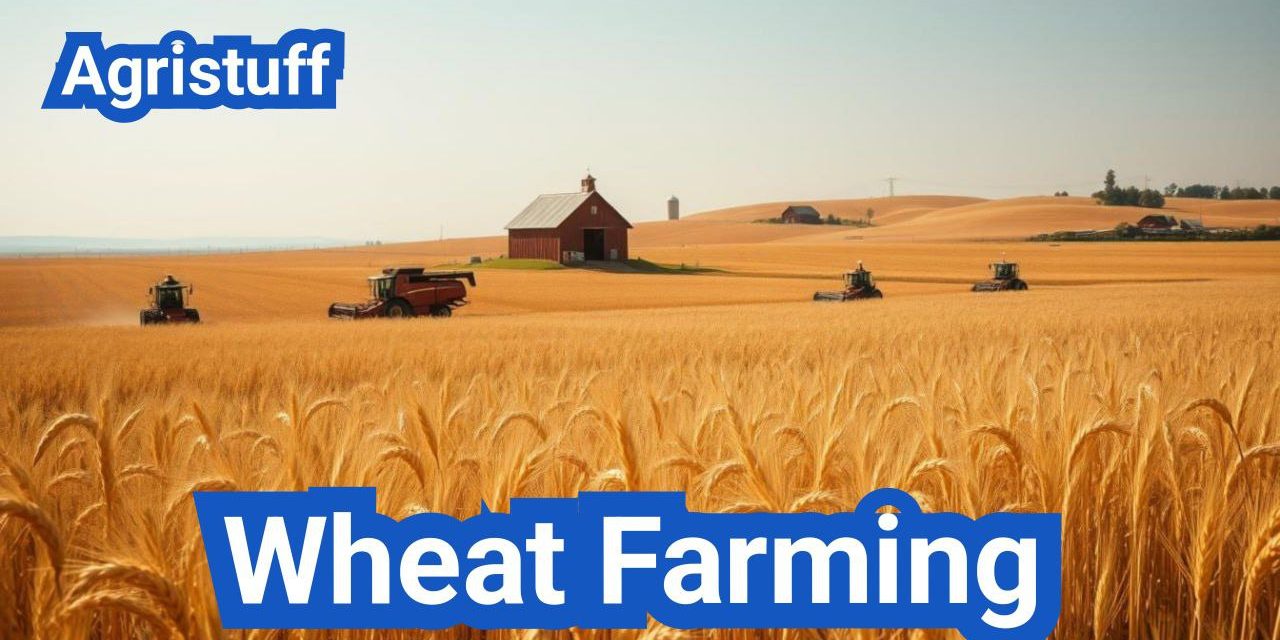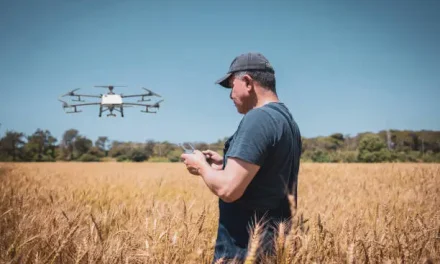Wheat is one of the world’s most important crops, with U.S. farmers cultivating around 50 million acres. The significance of wheat farming cannot be overstated, as it plays a vital role in the global food supply.
Regenerative wheat farming and commercial wheat farming are two practices that have gained prominence in recent years. American wheat farmers are at the forefront of these methods, contributing substantially to the country’s agricultural output.
Understanding the fundamentals of wheat farming is crucial for farmers, agricultural businesses, and consumers alike. This comprehensive guide will cover everything from the basics to advanced techniques and technologies used in wheat cultivation.
Key Takeaways
- Wheat farming is a vital part of the global food supply.
- U.S. farmers grow around 50 million acres of wheat.
- Regenerative and commercial wheat farming are significant practices.
- American wheat farmers contribute substantially to the country’s agricultural output.
- Wheat cultivation involves various techniques and technologies.
The Fundamentals of Wheat Farming
Understanding wheat farming’s core principles is essential for farmers worldwide. Wheat has been a staple crop for over 10,000 years, cultivated in diverse climates and soils across six continents.
What is Wheat and Its Global Importance
Wheat is a cool-season crop that thrives in temperate climates. Its global importance cannot be overstated, as it is a staple food for millions of people around the world. Wheat is rich in carbohydrates, fiber, and various nutrients, making it a vital component of many diets.
The global wheat market is influenced by factors such as climate change, trade policies, and consumer preferences. As a result, understanding wheat’s global importance is crucial for farmers, policymakers, and consumers alike.
History and Evolution of Wheat Cultivation
The history of wheat cultivation dates back thousands of years, with evidence of its cultivation found in ancient civilizations. Over time, wheat cultivation techniques have evolved significantly, driven by advances in technology, breeding programs, and farming practices.
From traditional farming methods to modern precision agriculture, wheat cultivation has adapted to changing environmental conditions and consumer demands. This evolution has enabled wheat to remain a vital crop globally.
The Economic Impact of Wheat Production
The economic impact of wheat production is significant, supporting rural communities, mills, bakeries, and other industries. Wheat production contributes to the livelihoods of millions of farmers and agricultural workers worldwide.
In addition to its economic benefits, wheat production also plays a crucial role in food security, particularly in regions where it is a primary staple crop. As such, understanding the economic impact of wheat production is vital for ensuring sustainable agricultural practices and food systems.
Types of Wheat Varieties for Farming

With thousands of wheat varieties grown worldwide, farmers have a wide range of options to choose from. These varieties can be broadly classified based on the time of planting, grain hardness, and heritage or specialty characteristics.
Winter vs. Spring Wheat Varieties
Wheat varieties are often categorized into winter and spring wheat based on their planting and harvesting seasons. Winter wheat is planted in the fall, goes dormant during the winter, and is harvested in the summer. This type of wheat is known for its higher yields and is often used for bread making due to its high protein content.
Spring wheat, on the other hand, is planted in the spring and harvested in late summer or early fall. It typically has a lower yield compared to winter wheat but is preferred in regions with harsh winters where winter wheat cannot survive.
Hard and Soft Wheat Classifications
Wheat is also classified based on grain hardness into hard wheat and soft wheat. Hard wheat varieties are known for their high protein content, making them ideal for bread making. They are often used in the production of high-quality bread and other yeast-leavened products.
Soft wheat, with its lower protein content, is more suited for cakes, pastries, and other baked goods. It is also used in the production of pastry flour and all-purpose flour for general baking purposes.
Heritage and Specialty Varieties
In recent years, there has been a growing interest in heritage and specialty wheat varieties such as Red Fife and Kamut. These varieties are prized for their unique characteristics, nutritional profiles, and historical significance.
Heritage and specialty wheats offer farmers a niche market opportunity, as they can command a premium price due to their distinct qualities and the growing demand for artisanal and organic products.
Essential Requirements for Successful Wheat Farming
Wheat farming requires a deep understanding of the interplay between climate, soil, and water management. Achieving optimal yields in wheat cultivation depends on carefully managing these critical factors.
Climate and Environmental Factors
Wheat is a cool-season crop that thrives in temperate climates with moderate temperatures and rainfall. Optimal temperature ranges vary depending on the wheat variety, but generally, wheat grows best in temperatures between 60°F and 75°F (15°C to 24°C).
- Adequate moisture during germination and growth stages
- Moderate temperatures during grain filling
- Avoidance of extreme weather conditions like frost or drought
The environmental impact of wheat farming can be significant, and understanding these factors is crucial for sustainable practices.
Soil Requirements and Preparation
Soil preparation is a critical step in wheat farming. Wheat prefers well-draining, fertile soils with a pH between 6.0 and 8.0. Soil testing is essential to determine nutrient levels and pH, allowing for appropriate amendments.
- Conduct thorough soil testing before planting
- Add necessary nutrients based on soil test results
- Ensure proper soil drainage to prevent waterlogging
Water Management and Irrigation Systems
Adequate water supply is crucial for wheat growth, particularly during germination, growth, and grain filling stages. Irrigation systems can supplement rainfall in areas with limited moisture, ensuring consistent yields.
- Monitor soil moisture levels regularly
- Implement efficient irrigation systems to minimize water waste
- Consider using drip irrigation for optimal water delivery
Effective water management not only enhances yields but also contributes to the sustainability of wheat farming operations.
Wheat Cultivation Techniques

Effective wheat cultivation techniques are crucial for a successful harvest. Wheat farming requires a deep understanding of various practices that contribute to a healthy crop and maximum yield.
Seed Selection and Treatment
Selecting the right wheat seeds is a critical step in the cultivation process. High-quality seeds that are resistant to diseases and pests are essential for a robust crop. Seed treatment with fungicides and insecticides can provide additional protection against early-season threats, ensuring a stronger start for the crop.
According to agricultural experts, “The choice of wheat variety can significantly impact the overall yield and quality of the crop.” Therefore, farmers should consider factors like climate, soil type, and pest prevalence when selecting seeds.
Planting Methods and Equipment
The method of planting wheat can vary significantly depending on the region, farm size, and available equipment. Traditional tillage practices are still widely used, but many farmers are adopting conservation tillage or no-till methods to reduce soil erosion and improve soil health.
The choice of planting equipment is also crucial. Modern drills and air seeders allow for precise seed placement and spacing, which can improve crop uniformity and yield.
Planting Schedules and Timing Considerations
Timing is everything when it comes to planting wheat. The optimal planting schedule depends on the wheat variety, climate, and region. Generally, winter wheat is planted in the fall, while spring wheat is planted in early spring. Understanding these timing considerations is vital for maximizing yield and minimizing the risk of crop failure.
As noted by agricultural specialists, “Planting wheat at the right time is critical for ensuring the crop has the best chance to thrive.” This involves careful planning and consideration of weather forecasts to make informed decisions.
Effective Wheat Crop Management
Managing wheat crops effectively involves a combination of fertilization, pest control, and weed management. These practices are crucial for maximizing yields and minimizing losses in wheat farming.
Fertilization Strategies and Nutrient Management
Fertilization is a critical component of wheat crop management. It involves applying the right type and amount of nutrients at the appropriate time to support healthy plant growth. Nitrogen, phosphorus, and potassium are essential nutrients for wheat production.
- Nitrogen promotes leaf growth and development.
- Phosphorus supports root development and overall plant health.
- Potassium helps with overall plant vigor and resistance to disease.
Soil testing is essential to determine the nutrient levels and pH of the soil, allowing farmers to make informed decisions about fertilization.
Pest and Disease Control in Wheat Fields
Pest and disease control are vital for protecting wheat crops from damage. Strategies include using resistant varieties, practicing crop rotation, and applying chemical controls when necessary.
- Resistant varieties help reduce the reliance on chemical pesticides.
- Crop rotation breaks the life cycle of pests and diseases.
- Chemical controls are used judiciously to minimize environmental impact.
Weed Management Approaches
Weed management is another critical aspect of wheat crop management. Approaches vary, with some farmers using herbicides, while others employ cultural practices like crop rotation and intercropping.
- Herbicides are effective for controlling weeds but must be used carefully to avoid environmental harm.
- Cultural practices like crop rotation and intercropping can suppress weed growth.
Effective wheat crop management requires a holistic approach, integrating fertilization, pest and disease control, and weed management to achieve optimal yields.
Modern Wheat Farming Technologies

The integration of modern technologies in wheat farming is enhancing productivity and sustainability. Modern wheat farming has adopted a range of technologies to improve efficiency, productivity, and sustainability.
Precision Agriculture Applications
Precision agriculture is revolutionizing wheat farming by enabling farmers to optimize inputs and reduce waste. Techniques such as GPS-guided planting and harvesting allow for precise application of seeds, fertilizers, and pesticides. This not only improves crop yields but also minimizes environmental impact.
Precision agriculture applications include the use of drones equipped with sensors to monitor crop health, detect pests and diseases, and assess soil moisture levels. This information enables farmers to make informed decisions, reducing the risk of crop failure and improving overall productivity.
Advanced Farming Equipment
Advanced farming equipment is another crucial aspect of modern wheat farming. The use of autonomous tractors and other automated machinery is becoming increasingly common, allowing farmers to automate tasks such as planting, spraying, and harvesting. This not only reduces labor costs but also improves the accuracy and efficiency of farming operations.
Drones and satellite imaging are also being used to monitor crop health and detect issues early, enabling farmers to take prompt action to prevent damage.
Data-Driven Decision Making
Data-driven decision making is at the heart of modern wheat farming. By leveraging data analytics and machine learning, farmers can gain valuable insights into their operations, from soil health to weather patterns. This information enables them to make informed decisions about planting, irrigation, and harvesting, ultimately improving crop yields and reducing waste.
The use of data analytics tools allows farmers to predict yields, identify areas for improvement, and optimize their farming practices. This data-driven approach is transforming the wheat farming industry, enabling farmers to produce more with less.
Sustainable Wheat Farming Practices

The future of wheat farming lies in sustainable practices that prioritize soil health and biodiversity. As the global demand for wheat continues to rise, adopting sustainable methods is crucial for ensuring the long-term viability of this staple crop.
No-Till Wheat Farming Methods
No-till wheat farming is a conservation agriculture practice that minimizes soil disturbance, preserving soil organic matter and reducing erosion. This method not only improves soil health but also decreases the environmental impact of farming.
Benefits of No-Till Farming:
- Reduced soil erosion
- Improved soil moisture retention
- Enhanced soil biodiversity
Crop Rotation Strategies with Wheat
Crop rotation is a vital strategy in sustainable wheat farming, involving the rotation of wheat with other crops to break disease and pest cycles, improve soil fertility, and enhance ecosystem services. This approach can significantly contribute to the overall health and productivity of the farm.
Effective Crop Rotation Strategies:
- Rotating wheat with legumes to improve soil nitrogen
- Incorporating cover crops to enhance soil health
- Alternating between different crop families to reduce pests and diseases
Regenerative Wheat Farming Approaches
Regenerative wheat farming focuses on regenerating soil health, promoting biodiversity, and sequestering carbon. This holistic approach not only improves the farm’s ecological footprint but also enhances its resilience to climate change.
Key Principles of Regenerative Farming:
- Minimizing external inputs
- Promoting soil organic matter
- Enhancing ecosystem services
Organic Wheat Farming

With the rising awareness of environmental issues, organic wheat farming is becoming an increasingly important aspect of modern agriculture. Organic wheat farming involves producing wheat without the use of synthetic fertilizers, pesticides, or genetically modified organisms (GMOs), prioritizing soil health, biodiversity, and ecosystem services.
Principles and Practices of Organic Production
Organic wheat farming is guided by principles that focus on sustainable agricultural practices. This includes maintaining soil fertility through natural means, such as crop rotation and the use of organic amendments. Farmers practicing organic wheat production avoid using synthetic pesticides and herbicides, instead opting for integrated pest management techniques that utilize natural predators and cultural controls.
The use of crop rotation is a key practice in organic wheat farming, helping to break disease and pest cycles, improve soil health, and increase biodiversity. Organic farmers also employ conservation tillage methods to reduce soil erosion and promote water retention.
Certification Requirements and Process
To be labeled as organic, wheat farms must undergo a certification process. This involves adhering to strict standards set by regulatory bodies, such as the USDA National Organic Program (NOP) in the United States. Farmers must maintain detailed records of their farming practices, including soil testing, crop rotation plans, and pest management strategies.
The certification process typically involves an initial application, inspection by a certifying agent, and annual renewal. Compliance with organic standards is verified through on-site inspections, ensuring that farmers adhere to the principles of organic production.
Market Opportunities and Price Premiums
Organic wheat farmers can access premium markets and prices for their products, providing a financial incentive for adopting organic practices. The demand for organic wheat is driven by consumers seeking healthier and more sustainably produced food options.
Organic wheat can be sold into various markets, including food manufacturers, bakeries, and directly to consumers through farmers’ markets or online platforms. The price premium for organic wheat can vary depending on market conditions and the specific certification standards met by the farmer.
By adopting organic wheat farming practices, farmers not only contribute to a more sustainable agricultural system but also benefit from the economic opportunities presented by the growing demand for organic products.
Specialized Wheat Farming Methods

Wheat farming is diversifying with new, specialized methods. These innovative approaches cater to diverse environments, markets, and consumer preferences, offering opportunities for farmers to adapt to changing conditions and capitalize on emerging trends.
Dryland Wheat Farming Techniques
Dryland wheat farming involves growing wheat without irrigation, relying on rainfall and soil moisture. This method is particularly relevant in regions with limited water resources. Effective dryland farming techniques include using drought-resistant wheat varieties, implementing conservation tillage, and optimizing soil health to improve water retention.
Conservation tillage, for instance, reduces soil disturbance, preserving moisture and reducing erosion. Farmers may also use crop rotation to enhance soil fertility and structure, further supporting dryland wheat cultivation.
| Technique | Description | Benefits |
|---|---|---|
| Drought-Resistant Varieties | Wheat varieties bred to thrive with minimal water | Improved yields in dry conditions |
| Conservation Tillage | Reducing soil disturbance to preserve moisture | Less erosion, better water retention |
| Crop Rotation | Rotating crops to enhance soil health | Improved soil fertility, structure |
Hydroponic and Vertical Wheat Farming
Hydroponic and vertical wheat farming represent a significant departure from traditional soil-based agriculture. These soilless cultivation methods allow for precise control over growing conditions, potentially increasing yields and reducing environmental impact.
Hydroponic systems deliver nutrients directly to the roots, while vertical farming stacks layers of crops, maximizing space. These methods are particularly suited to urban areas or regions with challenging soil conditions.
Small-Scale and Urban Wheat Production
Small-scale and urban wheat production involve growing wheat in limited spaces, such as backyards, rooftops, or indoor facilities. These approaches provide opportunities for local food systems and urban agriculture, allowing consumers to produce their own wheat or purchase it from local farmers.
Urban wheat production can also serve educational purposes, teaching city dwellers about agriculture and sustainability. While challenging due to space and environmental constraints, innovative solutions like vertical farming and hydroponics make urban wheat production feasible.
Wheat Harvesting and Post-Harvest Handling

Harvesting wheat at the right time and handling it properly post-harvest are essential for maximizing yield and quality. Wheat harvesting and post-harvest handling involve a range of practices that are critical to the overall success of wheat production.
Determining Optimal Harvest Timing
Determining the optimal time for wheat harvest is crucial. This involves monitoring the crop’s maturity, moisture content, and weather conditions. Optimal harvest timing ensures that the wheat is harvested when it is dry enough to store safely but not so dry that it becomes prone to shattering.
- Monitor crop moisture content regularly.
- Check for signs of maturity, such as the color and hardness of the grains.
- Keep an eye on weather forecasts to avoid harvesting during adverse conditions.
Harvesting Equipment and Techniques
The right harvesting equipment is vital for efficient wheat harvesting. Combines are commonly used for wheat harvesting as they can cut, thresh, and separate the grain in a single operation.
Effective harvesting techniques include:
- Adjusting the combine settings according to the crop conditions.
- Maintaining the equipment regularly to prevent breakdowns.
- Operating the machinery at optimal speeds to minimize grain loss.
Storage, Drying, and Processing
After harvesting, proper storage, drying, and processing of wheat are essential to maintain its quality. Grain storage facilities should be clean, dry, and pest-free.
Drying wheat to a safe moisture level is critical to prevent spoilage. Various drying methods can be employed, including:
- Natural air drying.
- Mechanical drying using grain dryers.
Once dried, wheat can be processed for various end-uses, including flour milling and animal feed production.
Economics of Commercial Wheat Farming

Understanding the economic aspects of commercial wheat farming is essential for farmers and stakeholders. Commercial wheat farming involves large-scale production for market sale, with farmers facing various economic considerations.
Typical Yields and Profit Margins Per Acre
Typical yields and profit margins per acre in commercial wheat farming vary significantly depending on factors such as climate, soil quality, and market conditions. For instance, farmers in regions with favorable climate conditions can achieve higher yields and better profit margins.
The average yield for wheat can range from 40 to 80 bushels per acre, with profit margins influenced by production costs, including seeds, fertilizers, and equipment. Strategies to optimize these costs can significantly impact profitability.
- Average yield: 40-80 bushels per acre
- Factors influencing profit margins: production costs, market prices, and yield
Market Considerations and Price Fluctuations
Market considerations and price fluctuations play a crucial role in the economics of commercial wheat farming. Global demand, trade policies, and weather conditions can cause significant price volatility.
Farmers must stay informed about market trends and adjust their strategies accordingly to maximize profitability. This includes understanding global supply and demand dynamics, as well as local market conditions.
Strategies for Maximizing Profitability
To maximize profitability, commercial wheat farmers can adopt several strategies, including optimizing inputs, improving efficiency, and diversifying products.
- Optimizing inputs: Using the right amount and type of seeds, fertilizers, and pesticides.
- Improving efficiency: Implementing precision agriculture techniques and maintaining equipment.
- Diversifying products: Exploring value-added products or alternative crops.
By understanding and implementing these strategies, farmers can better navigate the economic challenges of commercial wheat farming and improve their bottom line.
Global Perspectives on Wheat Farming

As a staple crop, wheat is cultivated in nearly every region of the world, highlighting its global importance. The cultivation of wheat is influenced by a variety of factors including climate, soil type, and agricultural practices.
American Wheat Industry Overview
The American wheat industry is a significant player in global wheat production. The United States is among the top wheat-producing countries, with major production areas including the Great Plains region. The industry is characterized by advanced farming techniques and a strong market presence.
Key aspects of the American wheat industry include its reliance on technology for farming, the importance of trade policies, and the impact of climate change on production. The U.S. wheat industry is also known for its high-quality wheat, which is used for a variety of products including bread, pasta, and pastries.
International Wheat Production
International wheat production is a complex process, involving multiple countries and agricultural practices. Global wheat production trends are influenced by factors such as climate change, trade policies, and global demand. Countries like China and India are among the top wheat producers, alongside the United States.
The global wheat market is subject to fluctuations in supply and demand, which can impact prices and production levels. Understanding these dynamics is crucial for stakeholders in the wheat industry.
The Role of Organizations Like FAO in Wheat Production
Organizations like the Food and Agriculture Organization (FAO) of the United Nations play a crucial role in promoting wheat production and food security worldwide. The FAO works to improve agricultural practices, support sustainable farming, and enhance food security in vulnerable regions.
FAO’s initiatives include providing technical assistance to farmers, supporting research and development in agriculture, and promoting policies that support sustainable agriculture. By working together with governments, farmers, and other stakeholders, the FAO helps to ensure a stable global food supply.
Finally: The Future of Wheat Farming
The future of wheat farming is poised to be shaped by several key factors, including climate change, technological innovation, and evolving consumer preferences. As the global population continues to grow, wheat will remain a vital crop, providing food and nutrition for millions worldwide.
Sustainable wheat farming practices and modern wheat farming technologies will be crucial in ensuring the long-term viability of wheat production. By adopting innovative production methods and embracing sustainable practices, farmers can improve crop yields, reduce environmental impact, and meet the demands of a changing world.
The integration of modern wheat farming technologies, such as precision agriculture and data-driven decision making, will enable farmers to optimize their production processes, reduce waste, and promote sustainable agriculture. As the wheat industry continues to evolve, it is essential to prioritize sustainable wheat farming practices that balance economic, social, and environmental considerations.
FAQ
What are the different types of wheat varieties used for farming?
Wheat varieties can be broadly classified into winter and spring wheat, based on the time of planting and harvesting. Hard wheat varieties are high in protein and are often used for bread making, while soft wheat varieties are lower in protein and are used for cakes, pastries, and other baked goods.
What are the essential climate and environmental factors for successful wheat farming?
Wheat is a cool-season crop that prefers temperate climates with moderate temperatures and rainfall. Understanding climate and environmental factors is crucial for successful wheat production.
How do I prepare the soil for wheat farming?
Soil preparation is critical, with wheat preferring well-draining, fertile soils with a pH between 6.0 and 8.0. Soil testing and amendment strategies can help optimize soil conditions for wheat growth.
What are the best practices for wheat crop management?
Effective wheat crop management involves fertilization strategies, pest and disease control measures, and weed management approaches. Crop rotation strategies can also help break disease and pest cycles, improve soil fertility, and enhance ecosystem services.
How can I maximize yields and profitability in commercial wheat farming?
Strategies for maximizing profitability include optimizing inputs, improving efficiency, and diversifying products. Understanding market considerations, including price fluctuations, global demand, and trade policies, is also crucial.
How does organic wheat farming differ from conventional wheat farming?
Organic wheat farming involves adhering to strict standards, including avoiding synthetic fertilizers and pesticides, and maintaining detailed records. Organic production principles prioritize soil health, biodiversity, and ecosystem services.
What are the advantages of using modern wheat farming technologies?
Modern wheat farming technologies, such as precision agriculture applications, advanced farming equipment, and data-driven decision making, can help improve efficiency, productivity, and sustainability.
Can wheat be grown using hydroponic or vertical farming methods?
Yes, hydroponic and vertical wheat farming use soilless cultivation methods, often in controlled environments, to produce wheat. These methods can provide opportunities for local food systems and urban agriculture.
How do I determine the optimal harvest timing for wheat?
Determining optimal harvest timing involves monitoring crop maturity, moisture content, and weather conditions. Harvesting equipment, such as combines, is used to cut, thresh, and separate the grain.
Conclusion of: Wheat Farming
Wheat farming is one of the oldest and most important agricultural practices in human history. As a staple food crop, wheat plays a vital role in feeding the world’s population and driving rural economies. This article provides a comprehensive overview of wheat farming—from its significance and methods to the tools, technologies, and challenges involved.
The Importance of Wheat Farming
Wheat farming is essential for global food security. Wheat is a major source of carbohydrates, protein, and essential nutrients. In the United States, wheat is grown across vast acreages, particularly in states like Kansas, North Dakota, and Montana. USDA Wheat Data
Types of Wheat and Their Uses
There are several types of wheat cultivated around the world, including hard red winter, hard red spring, soft red winter, white, and durum wheat. Each variety has unique qualities suitable for different end products such as bread, pasta, and pastries. National Association of Wheat Growers
Climate and Soil Requirements for Wheat Farming
Wheat farming requires specific climate and soil conditions. Ideal conditions include well-drained loamy soil and a temperate climate with moderate rainfall. Farmers often perform soil testing before planting to ensure optimum nutrient levels. FAO on Wheat Farming
Land Preparation for Wheat Farming
Land preparation in wheat farming begins with plowing, harrowing, and leveling the field. These steps are crucial to ensure good seedbed conditions and weed control. In some regions, conservation tillage is used to preserve soil moisture and reduce erosion. NRCS Conservation Practices
Wheat Planting Techniques
Wheat can be planted using broadcasting or drilling methods. The drilling method ensures better seed distribution and depth control, leading to uniform germination. Optimal planting time varies by region, but generally occurs in the fall or spring. University of Minnesota Extension
Irrigation in Wheat Farming
Although wheat is relatively drought-tolerant, irrigation becomes necessary in areas with low rainfall. Efficient irrigation methods such as sprinkler or drip systems are commonly used to conserve water while ensuring crop growth. Irrigation Association
Fertilization and Weed Management
Fertilization is a critical part of wheat farming. Nitrogen, phosphorus, and potassium are key nutrients required for healthy crop development. Integrated weed management—including herbicides and crop rotation—helps control unwanted plants and maximize yields. Purdue University Weed Science
Pest and Disease Control
Wheat farming often faces threats from pests such as aphids and diseases like rusts and smuts. Farmers use resistant varieties and follow integrated pest management (IPM) practices to minimize damage. USDA ARS Wheat Health
Harvesting Wheat
Wheat is harvested when the grains reach physiological maturity and the moisture content drops below 20%. Modern combine harvesters are used to cut, thresh, and clean the grain in a single pass, making harvesting efficient and less labor-intensive. John Deere Harvest Equipment
Post-Harvest Handling and Storage
Proper post-harvest handling in wheat farming is essential to maintain grain quality. Grains are dried to about 12% moisture and stored in silos or grain bins to prevent spoilage and pest infestation. Grain Storage Guidelines – Kansas State University
Sustainable Practices in Wheat Farming
Sustainable wheat farming includes crop rotation, reduced tillage, cover cropping, and precision agriculture techniques. These practices improve soil health, conserve resources, and boost long-term productivity. Sustainable Agriculture Research and Education (SARE)
Wheat Farming Technologies
Advancements in technology have transformed wheat farming. GPS-guided tractors, drones, and AI-based crop monitoring tools help farmers make data-driven decisions, increasing yields and profitability. AgFunder News on AgTech
Economic Impact of Wheat Farming
Wheat farming contributes significantly to the U.S. economy through domestic consumption and exports. It supports thousands of jobs in agriculture, transportation, and food industries. USDA Economic Research Service
Challenges Facing Wheat Farming
Climate change, rising input costs, and market volatility are some of the biggest challenges in wheat farming. Farmers must adapt through innovation, policy support, and access to real-time information. World Bank on Climate Smart Agriculture
Final Thought
Wheat farming remains a cornerstone of global agriculture, playing a key role in food security and rural livelihoods. With ongoing innovations in sustainable practices and technology, the future of wheat farming is both promising and dynamic.










